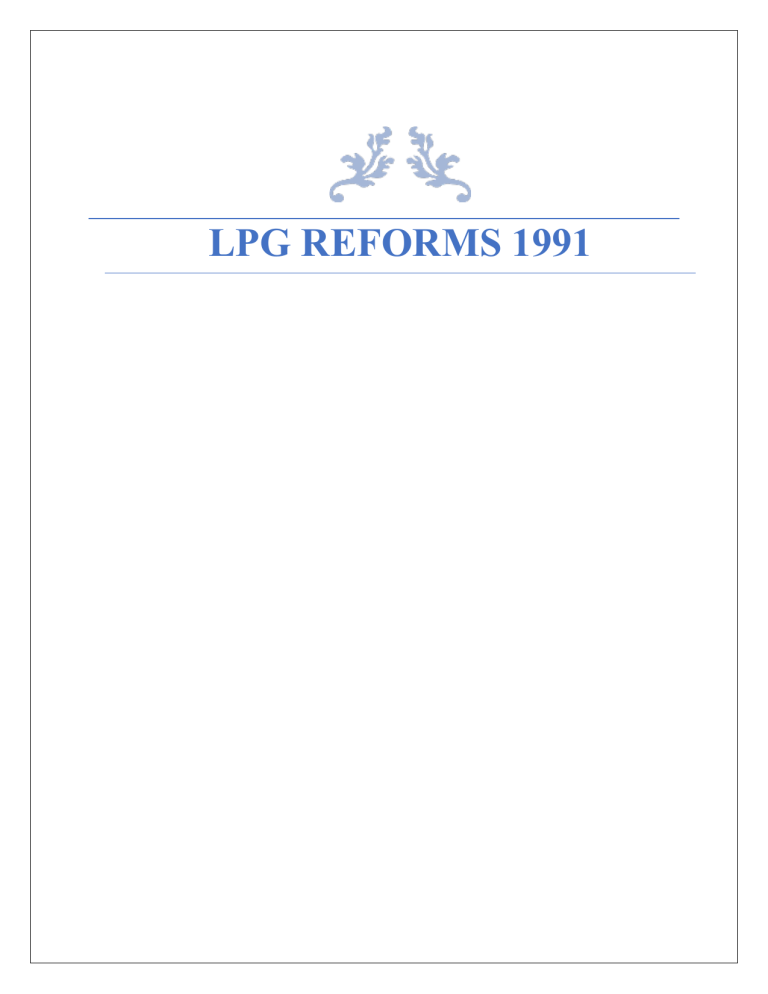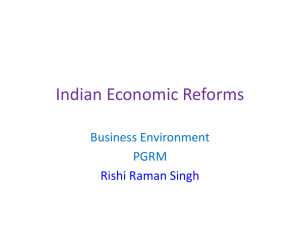
LPG REFORMS 1991 Introduction: Indian Economy (1947-1991) India faced widespread hunger and poverty along with agrarian and industrial crisis after the independence in 1947, the British rule was thus seen as exploitative by Indian leaders who were exposed to centrally planned Soviet Union economy and saw socialism as a means to empower the poor farmers and laborers. The economic policy of India post-independence was influenced by Government intervention under which the State exerted total ownership and control of railways and had majority stakes and control in Banking, electricity, oil and gas, power, etc. Indian Economy during this time was categorized as Dirigism (State playing central directive role) as strong impetus was placed by the Government on protectionism of the domestic industries with emphasis on economic intervention at central level, import substitution industrialization, large public sector run by Government, central planning and business regulations. Five-year plans were set up which were inspired by the Soviet Union Central Planning. Five-Year Plans: The Five-Year Plans were set up with the objective of increasing the standard of living and focused on a wide range of objectives like ensuring full employment and removal of structural inequities. It also focused investing in the public projects to work on building the infrastructure. Emphasis was placed on labor intensive method of mass production of consumer goods so as to generate more employment while also ensuring faster growth of income. Another dominant aspect was the import substitution-based strategy of industrialization introduced in the Second Five Year Plan. Under this, thrust was placed on creating domestic capacity for the production of capital goods. To achieve this, the Public Sector promoted infrastructural facilities growth, increased capacity in the heavy and basic industries and reduced of economic power concentration by expanding public ownership of various means of production. This was accomplished through investments in infrastructure such as roads, railways, etc. and its intermediaries like coal, power, steel, etc. Sector Analysis: Agriculture: Agriculture received primary importance in the policy formulation after Independence. In the following decades, several Land Reforms were passed. These Land Reforms had the following objectives: Removal of hindrances and impediments on agricultural produce arising out of the agrarian structure of the rural areas. Elimination of exploitation of small or landless cultivators through implementation of land redistribution. Land Reforms were of the following main categories: Abolishment of intermediaries who were designated rent collectors during Colonial India under the Land Revenue system 1 Improving the contractual terms of tenants through Tenancy Regulations Redistribution of surplus lands to the landless through a ceiling on land holding Consolidation of disparate landholdings. Green Revolution: By the mid-1960s, India had to revolutionize farming to achieve self-sufficiency in food grains. This was done through the introduction of High Yielding Varieties Seeds (HYV). These technologically advanced seeds yielded more than twice the existing levels from 74 mt (million tonnes) in 1966-67 to 105 mt in ‘71-72 and dramatically increased wheat and rice production. Rural poverty decreased to 56% in ’73 from 64% in ’67. Following two droughts consecutively in 1972-73, production of food grain reduced by 7.7% and the country then had to again import food grains from US. The Government then increased fertilizer subsidies as well to prevent decrease in consumption after the increase in fertilizer prices following the Oil Shock of the 70s. During the period of Green Revolution, Agriculture was subjected to highly regulated policy structure, marked by restrictions imposed on production by barriers to entry and licensing requirements along with price controls, private trading and movement of the produce of agriculture. It was also subjected to tariffs and non-tariff barriers for trade flows from agriculture. Period Growth Rate of Agriculture and Related Sector 1951-52 to ’67-’68 (Pre-Green Revolution) 2.54% 1968-69 to 1980-81 (Green Revolution) 2.44% 1981-82 to 1990-91 Dissemination at wider scale) (Technology 3.52% 1991-92 to 1996-97 (Early Reform Period) 3.66% 1997-98 to 2001-02 (9th Plan) 2.5% 2002-03 to 2006-07 (10th Plan) 2.47% Source: Eleventh Five Year Plan 2007-2012 Industry and Trade: After the independence, Indian industrialists did not have the requisite capital to carry out investments in industrial ventures. State thus had to step in and play extensive role in developing the industrial sector. The State also took control over industries that were considered essential for the economy such as coal, iron, aircraft manufacturing, etc. Industrial Policy Resolution 1956: This resolution categorized industries into 3 classifications: State having complete ownership of industries Industries in which private companies would work with the State 2 Industries in which Private Sector can have complete ownership License Requirement: Even though there were some sectors in which the private sector was allowed to operate, State still maintained control over them through License Permit. Industries had to obtain License Permit in order to operate. Existing industries had to seek permits to expand their operations. Through all of this the government controlled the means and quantity of supply in the economy. Import Substitution: State sought to protect nascent domestic industries from foreign competition. This was done through tariffs and quotas. High duties were levied to discourage imports. Year Manufacturing % of GDP 1990 16.6 1995 17.8 1997 16.5 2000 15.9 2006 17.3 2008 17.1 2012 15.82 2015 15.58 2019 13.65 Source: World Bank Data Objectives of the Study: Through this study, we aim to understand the evolution of Indian Economy from a closed one to now a global powerhouse. India in the last 3 decades has become one of the most sought-after destination for investment and manufacturing for many foreign MNCs due to its large middle-class base which also represent a strong consumer base and English speaking educated youth. India has also recorded one of the highest GDP growth rates in the recent past and now is one of the Emerging Economies. We seek to understand the various schemes and policies undertaken by the State in the early 90s to put India to the path towards one of the biggest economies in the world in GDP terms. Background of Economic Reforms in 1991 Economic problems of the country had started in 1980s, when India faced double deficit, trade balance was running in deficit along with the increased public spending which was more than the revenue leaving a budget deficit. India faced economic crisis in 1991 as a result of various factors. Soviet Union which was India’s major trading partners had collapsed. Gulf War of 1991 had increased the oil prices and caused a blockage of remittances from Indian workers in Middle East. The imports had increased, exports were low and India did not have enough foreign reserves to 3 pay import bills of 21 days. The government also came on the verge of financial obligations default and then the Rupee had depreciated which further worsened the twin deficits problem. The IMF and World Bank agreed to give a reform package under the condition that the country change its economic policies and encourage trade and liberalization. Key Features of the Economic Reforms: The reform package as created by then Finance Minister (Hon.) Mr. Manmohan Singh had the following three features: Managing the fiscal deficit through fiscal stabilization and bringing it down in a way that public investments in economic and social infrastructure can be increased without creating inflationary pressures. Liberalize the internal structure to improve competition. Giving the private sector freedom to make their own investment and product decisions based on the prevailing market conditions and thus increasing the scope and freedom of the private sector. Integrate India with the world economy through the removal controls on foreign exchange rates and trade, decreasing tariffs and easing the regulations regarding external capital outflows and create policies to attract Foreign Direct Investments (FDI) Structural Reforms Undertaken: These policies were formulated in order to increase the economic growth in the medium term. They were in the areas of industrial regulations and license requirements, foreign investments and trades and financial sector. 1. Industrial Policy Reforms: New Industrial Policy abolished the license permit requirement that regulated the investments in the industrial sector in all except for 5 industries. These industries had to be regulated because they were related to national security, social well being or presented environment hazards. Several new industries were now opened to private sector including investments from the foreign private sector. This was done by removing many industries from the listing of “Industries Reserved for Public Sector”. Only two industries were retained in this- atomic energy and railway transport. This opened a large number of industries such as Telecom, transport-road, ports, petroleum, coal, etc. for the private sector. FDI was opened for 100% in infrastructure sector. Small Scale Industry (SSI): To encourage healthy competition, industries reserved for the small-scale sector had to be reviewed regularly. The description of SSI was modified to encourage modernization and by 4 2014 only 20 sectors are reserved for SSIs. FDI of upto 100% was allowed in most of the sectors through the automatic route, with only a few exceptions. 2. Trade Policy Reforms: The licensing required for imports was abolished. The Non-Tariff barriers were gradually phased out from all tradable goods except for consumer based goods. Tariffs have substantially been reduced since then. As per the WTO agreement, India has taken initiatives to liberalize and improve its trade regime. Tariffs: Tariffs have come down drastically from a high of 150% in 1990 to 5.8% in 2010 in NonAgriculture sector. In agriculture sector, tariff was reduced from 19.3% in 2007-08 to 2.5% in 2009-10. In 2015-16 Budget, custom duties have been decreased from 10% to 2.5%. Quantitative Restrictions Removal: Import restrictions and quota removal process began in 1991, and since then been completely removed in a phased manner. 3. Financial Sector Reforms: The aim was to give flexibility of operations and autonomy and independence in functioning to banks and other financial institutions so that resource allocation was done efficiently and effectively. Some of the other essential initiatives taken were deregulation of interest rates and improving the transparency and standards of disclosure through implementation of prudential norms such as capital adequacy ratio, etc. Capital Markets: Foreign Institutional Investors (FII) could now invest in all types of tradable securities in the primary and secondary market without any restrictions on the volume or period of lockin. Online and dematerialized trading were also introduced. Securities and Exchange Board of India (SEBI) was appointed as the regulator of the capital market functioning. Companies were given permission of buy back of shares based on the regulations given by SEBI Money Market: Several instruments pertaining to the money market had been introduced such as Certificate of Deposits, 182 days Treasury Bill, Commercial Papers. In order to regulate and oversee the liquidity in the short term of the system, RBI which is the regulatory body of money market in India introduced repurchase transactions and Liquidity Adjustment Facility. Insurance Sector: Insurance sector was opened up to private sector players- both domestic and foreign. Insurance Regulatory and Development Authority (IRDA) was established, functioning as an autonomous body in order to oversee, regulate, foster and encourage competition. 5 Rationale for undertaking the measures 1. High Inflation: The inflation had increased to 15.6% in 1991, way above the set target of 9% (India Today, 1991) due to increase in money supply and uncontrolled government expenditure. 2. Loss of Investor Confidence: Increasing fiscal and current account deficit coupled with political uncertainty led to the loss of investor confidence. Several credit rating agencies such as Moody’s had downgraded India’s bond ratings after which the government could not pass the budget as well. The commercial bank borrowings became difficult and outflows started happening as investors began to pull their money out. 3. Rise in Adverse Balance of Payments: India’s negative BoP stood at Rs. 2214 cr in 1980-81 to Rs. 17,367 cr in 1990-91. Foreign exchange reserves had fallen to $1.2 billion in January 1991 and had depleted to half by June 1991. (RBI Docs) This made it difficult for the country to meet its contractual debt obligations. 4. Condition by IMF and World Bank: Relief package of $7 billion was given only on the condition that India announce its new economic policy and that concerted efforts are made to liberalize its industrial and financial sector while also allowing the foreign sector to investment in it. Macroeconomic Impact of LPG Policy: GDP: After the economic reforms of the 1990s, India’s real GDP began to consistently rise to an average of 5.7% in the ‘90s to an increased average of 7.3% in 2000s. One of the features of the high growth rates was the fast growth rate of service sector which was driven because of Information Technology (IT) boom inn the country. A key reason for high growth was high savings rate which was 36% and gross fixed capital formation which was at 37%(RBI PDF, 2012) Year GDP (%) 1996 7.55% 2002 3.8% 2006 8% 2007 7.6% 2008 3% 2012 5.4% 2015 7.9% 6 2018 6.12% 2019 4.1% Source: World Bank data Exports: The exports of the country have consistently since implementation of LPG reforms in 1991. The reasons behind this are the removal of restrictions that had been imposed earlier. Moreover, the Government has given various schemes in order to increase them such as extension of interest subvention scheme to increase exports related to textile and engineering sector (Nikhil Inamdar, 2013). Government also released various schemes to boost electronic exports such as Electronics Manufacturing Clusters scheme, etc. India also has become second biggest manufacturer of mobile phones. Year 1991 1995 2000 2006 2010 2015 2018 Export Value ($ million) 17,900 31,699 42,358 121,201 220,408 264,381 322,292 Source: World Bank Data FDI Inflows: FDI policy liberalization has seen a tremendous growth for FDI inflow from $200 million to $50.6 billion in 2019. In some categories Foreign Investments of upto 100% is also permitted. The government also has taken various measures to improve Ease of Doing Business rankings. Medical devices manufacturing and ATM operations white label now have been allowed 100% FDIs. There are major FDI inflows to sectors such as computer components like hardware and software, trading, automobile industry, construction, chemicals except for fertilizers and telecom industry. Year 1995 2000 2006 2008 2010 2015 2018 2019 Value ($ Billion) 2.1 3.5 20.02 43.4 27.3 44 42.11 50.6 Source: World Bank Data 7 Fiscal Deficit: Year 1990 1992 1995 2000 2005 2008 2009 2015 2018 2020 Rate in % of GDP 7.61 5.19 4.9 4.5 4.3 6.2 6.6 3.9 3.39 9.5 Source: Statista Fiscal Responsibility and Budget Management Act had been introduced in 2003 in order to check the Fiscal spending of government and set a target for the government to adhere to. Government has been successful in reigning fiscal deficit up until 2020 when the pandemic struck and the government had to release relief packages and stimulus. The government had so far been able to keep it in check through reduction in subsidies and increasing. Capital expenditure made by the government had also been reduced until 2000(Nagesh Kumar,2010). Non-tax revenue also had increased while expenditure was decreased (Business Today, 2018). Issues and Challenges in implementing LPG There was significant opposition from the political parties towards implementation of LPG 1991 on account of interference with the autonomy of the country. The Trade and Labor Unions were also opposed to it because of what they saw as an increase in power of capitalists which will affect the working class of the country. Several industrialists were also opposed to the economic reforms because they felt adequate protection would not be given to home grown industries and they could face stiff competition from global companies with advanced technologies. Labor Unions also felt that there would be an exploitation by industrialists in the face of weakening power of government in companies as their bargaining power now had reduced. 8 Conclusion: While LPG reforms have propelled India to become a global economic powerhouse; the prosperity seen has been limited to certain sectors and urban areas. While the incomes for White collar jobs have increased on account of increase in the number of MNCs and investments in private sectors such as IT, Telecom, Insurance, Financial Services; rural India is facing agricultural distress. Share of agriculture in the GDP of the country has been consistently declining even though it employs more than 70% of the country. There are major factors contributing to rural distress. There is a lack of long-term strategy for economic development in agriculture sector. The policies initiated also provide little incentives to the farmers considering the prices are very low. It also lacks proper research and development. No significant breakthrough has happened since the Green Revolution which is why there also has been a decline in productivity. There is still too much dependence on rains and groundwater has been highly exploited leading to unsustainable agriculture practices. Farm distress is a major problem for the country. Coronavirus also has affected the economy of the country. There has been a decrease in the rates of savings and investment. The growth in the current year is also expected to be in negative. The pandemic has spread with an increasing speed and has nearly halted economic activities across the globe as several countries have imposed travel restrictions. 9





![Application of Competition principles to Interconnection and Access [Session – 7]](http://s2.studylib.net/store/data/013688751_1-a1de10a3b537aea5c4e72d156a90fb63-300x300.png)